The Current Status of Tourism in Thailand in the COVID-19 Pandemic and Suggestions for the Revival of Inbound Tourism in Japan ~Breaking the National Isolationism under the COVID-19 and Reopening the Country~
- Colloquium
- Tourism
The 144th Transport Policy Colloquium Bangkok Report~Startup Series Part 1~
Upload a Seminar Recording
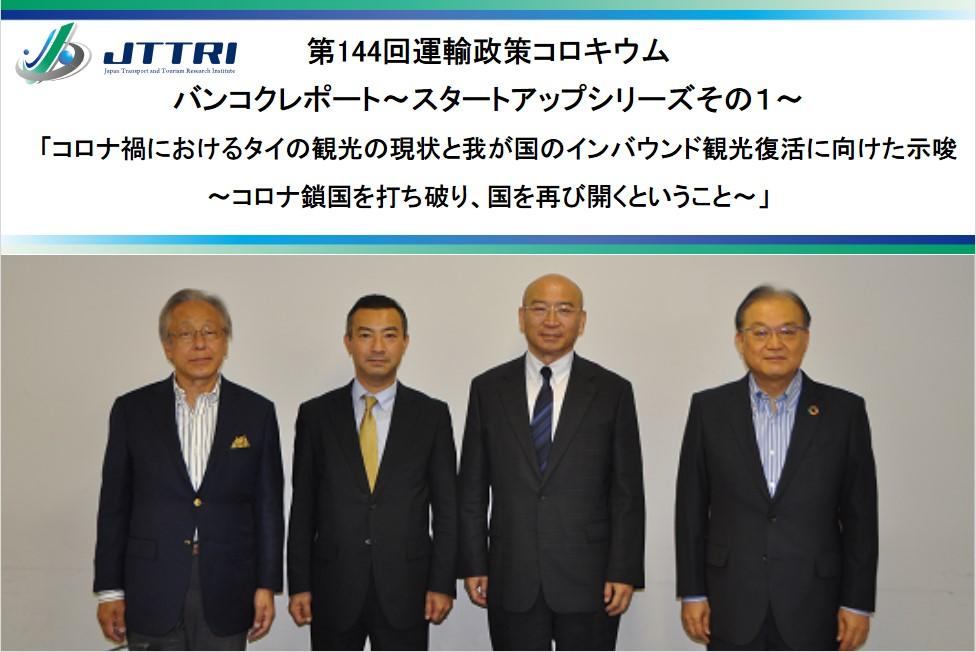

| Date / Time | Fri, Oct 15,2021 13:30~15:30 |
|---|---|
| Event Number | The 144th |
| Theme | The Current Status of Tourism in Thailand in the COVID-19 Pandemic and Suggestions for the Revival of Inbound Tourism in Japan ~Breaking the National Isolationism under the COVID-19 and Reopening the Country~ |
| Lecturer | Lecturer:SAWADA Takaaki Executive Director and Senior Research Fellow, Japan Transport and Tourism Research Institute ASEAN-India Regional Office Commentator:HASEGAWA Yasuhiro Professor,Department of Tourism Management Faculty of Economics,Teikyo University <Discussion> Coordinator:YAMAUCHI Hirotaka President for Research, Japan Transport and Tourism Research Institute (JTTRI) |
Event Summary
In this colloquium, the impact of the coronavirus infection (known as COVID-19) on tourism in Thailand was introduced. Also, the status of the Thai government’s response, as well as Thailand's efforts to revive inbound tourism in anticipation of the convergence of COVID-19 from the perspective of the ASEAN India Regional Office in Bangkok were discussed.Later, Professor Yasuhiro Hasegawa of the Department of Tourism Management, Faculty of Economics, Teikyo University was welcomed as a guest commentator. He described the importance of the tourism industry in Thailand and offered tips for recovering from COVID-19. He also discussed issues and measures for Japan designed for the future revival of inbound tourism.
This time, we welcomed 265 participants from research institutions at universities and the like, government agencies, and travel and aviation related business operators and the like. This created a rather large colloquium this time.
Program of the seminar is as the following
| Opening Remarks |
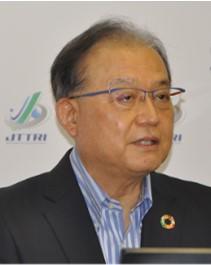
SHUKURI Masafumi |
|---|---|
| Lecturer |
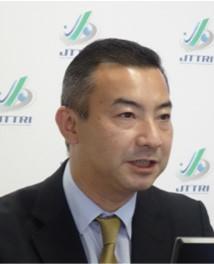
SAWADA Takaaki |
| Commentator |
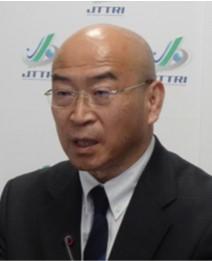
HASEGAWA Yasuhiro |
| Discussion |
<Coordinator>
YAMAUCHI Hirotaka President for Research, Japan Transport and Tourism Research Institute (JTTRI) 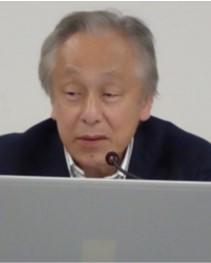
|
Outline of the seminar
Takaaki Sawada, Executive Director and Senior Research Fellow, Japan Transport and Tourism Research Institute
ASEAN-India Regional Office gave a presentation on the theme of The Current Status of Tourism in Thailand in the COVID-19 Pandemic and Suggestions for the Revival of Inbound Tourism in Japan
— Breaking the National Isolationism under the COVID-19 and Reopening the Country — The following are the key points of his presentation.
= The role of tourism in Thailand =
• Thailand is a major tourist country in Southeast Asia. Annually. It hosts approximately 40 million foreign visitors. By country and region, approximately 30% of their tourists come from mainland China. This accounts for the largest group.
• Overwhelmingly, the number of foreign visitors to Thailand can be found in the capital, Bangkok. After that, they can be found in Phuket Province, a southern beach resort, and Chon Buri Province, where Pattaya City a getaway resort in the east.
• The longer the average stay is, the farther away overseas travelers will have come. There are significant economic effects. In recent years, tourism-related revenue has accounted for nearly 20% of Thailand's GDP. Tourism has become a major industry in Thailand.
• The tourism administration is handled by the Ministry of Tourism and Sport (MOTS) and the Thailand National Government Tourism Agency (TAT). In particular, the TAT budget size and the network of domestic and international offices are large. Furthermore, TAT, the foreign office for MOTS, plays a commanding role in the promotion of tourism in Thailand.
= Effects of COVID-19 on Tourism in Thailand =
• There have been three waves of COVID-19 infection in Thailand, namely from the first to the third waves. As of early October, 2021, the cumulative number of infections there reached as many as approximately 1.7 million people. The cumulative number of COVID-19-related deaths has been approximately 17,000 victims.
• Vaccinations in Thailand will begin at the end of February, 2021. As of early in October, 2021, approximately 50% of the population have had their first vaccination, and approximately 30% of the population have completed their second vaccination.
• Although the Thai economy has suffered a decline from the first quarter of 2020, there has been a significant negative effect on the economy, since the second quarter of 2020, when the first lockdown was implemented in Bangkok. This includes a significant negative GDP growth rate and a sharp rise in the number of people who have lost their jobs.
• Tourism has suffered from the devastating effects the impact of the principle ban on the entry of foreigners that was implemented during the second quarter of 2020, and related subsequent measures such as immigrant quarantines. This has caused the proportion of tourism as a percentage of GDP to shrink significantly. The Thai government has taken actions to support tourism through measures to promote domestic travel. However, they have not attained a fundamental solution.
= Recommendations for the Reopening of the Country = (Referencing Efforts in Thailand)
① Easy immigration procedures
Measures should be implemented to simplify immigration documents, to make them multilingual, and for applications through proxy and the like. Instead of non-infection certificates, it is also desirable to introduce the use of a vaccine passport.
② Quarantine Policy
It is desirable to build a mechanism that generates competition between the selection of quarantined people and quarantine facilities, introduces quarantine facilities utilizing distinctive tourism resources, and that shortens the quarantine period for vaccinated visitors. (Ideally, there would be no quarantines). In addition, the types of vaccines that are allowed to shorten quarantine periods (exemption) should be based on WHO approval, without constraints imposed by national approval.
③ Giving peace of mind to travelers
A unified certification system should be introduced with reference to a national, uniform and cross-industry public health standard (SHA, SHA +) introduced in Thailand, and a mechanism should be built with incentives to obtain certification on the business side.
④ Efforts to revive inbound tourism
• Messages should be sent to industries, travelers, and the citizens of their own countries by showing in a process chart the introduction of measures to accept vaccinated foreign visitors without a quarantine period by limiting regions such as Phuket Sandbox or the like, and gradually expanding host regions.
• The Thai government has launched a policy to position tourism as one of the four industrial fields to be strengthened with a bio-circulation type, green economy (BCG economy) as a national strategic model, and a new policy to collect tourism tax from foreign travelers for the purpose of subsidizing reforms towards sustainable tourism.
Senior research fellow Sawada concluded his presentation by suggesting the need for Japan to find new value for inbound tourism even as it focuses on reopening the country, considering that Thailand is also finding value in tourism beyond economic effects. This includes establishing its own brand image, ensuring its presence, and its security guarantees.
Later, the following explanation and questions were taken by the commentator, Professor Yasuhiro Hasegawa of the Department of Tourism Management, Faculty of Economics, Teikyo University.
[Explanation]
• In 2019, Thailand hosted just under 40 million foreign visitors, the second highest number in Asia after China and the 8th in the world.
• Thailand's tourism industry accounts for approximately 20% of its GDP. It stands out among countries in Asia. Furthermore, while the international tourism revenues of Japan is ¥4.8 trillion, that of Thailand is ¥6.5 trillion, the fourth highest in the world. This should highlight the importance of tourism in Thailand.
• Obviously, the effects of the COVID-19 pandemic have been much larger than terrorism in the past (the simultaneous bombings in Bali), natural disasters (the Great East Japan Earthquake), and plagues (SARS in Hong Kong).
• Approximately 1.8 million Japanese people visited Thailand in 2019 and the number of the visitors to Japan from Thailand is approximately 1.32 million. These numbers are well-balanced. It shows a desirable relationship from the viewpoint of two-way tourism.
• Arakura-yama Sengen Park, and Fuji Sengen Shrine in Fujiyoshida City, Yamanashi Prefecture have become the famous spots for being able to capture a five-story pagoda, Mt. Fuji, and cherry blossoms in a single photograph. There has been a great boom thanks to SNS among the visitors from Thailand. In order to rebuild tourism in Japan, it is important to dig up this kind of hidden treasures and to popularize them along with efforts to ensure safety and security through SNS.
[Questions]
(1) The number of people infected with COVID-19 in Thailand is at a high level. What measures are the Thai government taking?
(2) The sandbox project is a policy intended for long-term residents. Isn't it necessary to take separate measures that take into account the Asian market, which is a majority with a short stay period?
(3) Thailand is focusing on medical tourism. However, do they have any solutions as COVID-19 has deterred the tourists from visiting Thailand? If the medical tourists venture visiting Thailand, are they capable to accommodate the medical tourists when the number of hospital beds is limited because of COVID-19 pandemic?
Senior research fellow Sawada responded to these questions as shown below.
(1) For the time being, the Thai government will adopt policies both for expanding regions that accept foreign visitors without a quarantine period to attain economic recovery, and for improving vaccination rates to control infections.
(2) The sandbox project has been approved on the condition that people who stay 14 nights or 7 nights or fewer will also return to their own countries. It cannot be said that the policy is not necessarily designed with only long-term residents in mind. Rather, it is speculated that the length of the quarantine period when the visitors return to their own country is causing short-term residents to hesitate to use sandbox.
(3) According to an interview with a hospital official, the number of patients from overseas has decreased drastically because of the COVID-19 pandemic, so they said that they were strengthening efforts targeting wealthy people in Thailand and foreigners who have already stayed in Thailand.
• Medical tourism in Thailand is carried out by a private hospital of a corporation that mainly deals with foreigners. Compared to public hospitals that focus on the treatment of local residents, there have been no opinions that hospital beds are in short supply.
[Panel Discussion]
As the coordinator, President of Japan Transport and Tourism Research Institute (JTTRI) Yamauchi discussed points of reference and issues for Japan in Thailand's efforts. The main discussion is shown below.
<Problems with implementing initiatives such as sandbox in Japan>
It is a characteristic initiative of Thailand, and if it is implemented in Japan, Okinawa and Hokkaido would be the likely candidates. Conversely, it is an initiative that specially handles certain regions, and there are differences in nationalities. It seems that there is a difficult aspect in Japan that values equality. Although we are watching how Japan handles the quarantine period in order to rebuild tourism, we frankly wonder whether we should really keep our hands on it in the competition with other countries.
<It is said that tourism will also be positioned in the bio-circulation type, green economy (BCG economy) as a future policy. I would like you to explain it in a little more detail from the viewpoint of suggestions for Japan>
The Thai government is looking ahead to the next 10 or 20 years by raising the country, and is seriously considering which fields in their country should be strengthened, not only tourism. With regard to tourism, there is a possibility that COVID-19 will change the style of tourism, and from the viewpoint of whether it will be a type of tourism for enjoying nature with a small number of people, there is a debate that puts the environment at the front with keywords such as "green" and "circulation type," but it is not yet possible to see what specifically will be done.
Regarding tourism taxes, there were some opinions opposing the introduction of international tourist tax and accommodation tax in Japan at the beginning. However, these taxes have been accepted in the process and now considered indispensable. In light of the example in Japan, it seems understandable that Thailand would need tourism taxes.
<What changes do you see in the status of activities by foreign companies such as Japanese companies in Thailand?>
As a result of the sharp decline in foreign travel to Thailand due to the COVID-19 pandemic, both Japanese and foreign companies have come to focus on the Thai market, especially companies such as travel agencies, hotels, hospitals, and department stores. Furthermore, businesses for remote work and new hygiene-related businesses are emerging. We feel the strength of the Thai market to respond flexibly to the times.
<What would be useful in Thailand's tourism policy for both economic recovery and infection control?>
There are three main things. 1. Introduction of a mechanism that generates competition between quarantine facilities in the quarantine policy; 2. Setting uniform national public health standards; and 3. Quarantine period exemptions for people who have had all their vaccinations (localized, and introduced gradually).
Overall Review
I was able to better understand the current situation in which Thailand is trying to defend its position as a tourist nation through various measures, and I was able to understand the high level of policy-making ability of the Thai government. There were many suggestions for Japan.
The end


